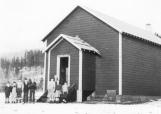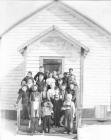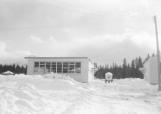1
Rules for teachers1872
Rules for Teachers
1872
1. Teachers each day will fill lamps, clean chimneys, and clean wicks.
2. Each teacher will bring a bucket of water and scuttle of coal for the day's session.
3. Make your pens carefully. You may whittle nibs for the individual tastes of the pupils.
4. Men teachers may take one evening a week for courting purposes or two evenings a week if they attend church regularly.
5. After ten hours in school, teachers should spend the remaining time reading the Bible or other good books.
6. Women teachers who marry or engage in unseemly conduct will be dismissed.
7. Each teacher who smokes, uses liquor in any form, frequents pool or public halls, or gets shaved in a barber shop, will give good reason to suspect his worth, intentions integrity, and honesty.
8. Each teacher shall lay aside from each day a goodly sum of his earnings for his benefit during the declining years so he will not become a burden on society.
9. The teacher who performs his labors faithfully and without fail for five years will be given an increase of 25 cents per week providing the Board of Education approves.
3
The Swift Creek Schoolhouse was used from September 1916 to June 1935. It was "centrally" located - where the arena is today. Fifteen students attended when school began.The schoolhouse was the centre of social life in the community. Clergymen and missionaries used to hold church services there.
The schoolhouse was destroyed in 1935 by a fire of unknown origin.
5
Valemount youngsters ham it up during the 1930's at the Little House Out BackBen Burgoyne and Herb Kelly are on the roof; Russ Clausen peeks through the window while Frank Burgoyne stands in front.
6
Teacher Laura Hollis outside the Valemount Schoolhouse1936-1952
Valemount, British Columbia, Canada

7
When the Swift Creek schoolhouse burnt in June 1935, school board trustee Johnston Mackenzie and other men of the district erected a new frame building on Main Street near the present Valemount Library during that summer. Laura Hollis was teacher at this school from 1935-1938. This school was used as the main school until another one was built in 1952.It was periodically deserted and fixed up to accommodate overflows from the new school during its construction and expansion. It also served as the old Valemount Library building.
9
Valemount Schoolhouse - built in time for September of 1935 after the log house burned in June.12
A new two-room school was built around 1952 off Fifth Avenue facing the present Coffeehouse. By 1956, accommodation had to be doubled. By 1962, two more rooms were added, as well as a gymnasium with a big stage.The space was so inadequate by 1965 that children were occupying all rooms, stage and the old schoolhouse. Some had to be accommodated in the church hall and in a portable annex that had been hauled in. Three more rooms were added and construction completed in September 1966. The McBride Centennial Choir came for the dedication ceremony.
The Principal was Mr. L.C. Frazer and there were 10 school employees at that time. By 1967, nine rooms and the portable were being used.
14
1974-75 was the first year that a class of Grade 12s graduated from the Valemount School. Until then, the Valemount Elementary Junior Secondary School offered classes up to grade 10. Most students went to McBride to finish their high school graduation, while staying in the dorm.In 1975, a separate elementary school was being constructed. The Junior Secondary School operated a morning shift for elementary students and an afternoon shift for secondary students that year.





